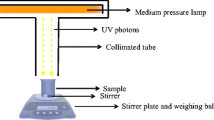Abstract
A photodegradation study of aflatoxin B1 (AFB1) in peanut oil was performed under UV irradiation at different AFB1 initial concentrations and UV irradiation intensities. The UV intensity and the irradiation duration on the AFB1 photodegradation ratio is more effective, when compared with AFB1 initial concentration, and AFB1 with initial concentration of 2 mg/kg can be degraded thoroughly within 30 min under the intensity of 800 μw/cm2. The photodegradation of AFB1 between the selected ranges of concentrations was proved to follow first-order reaction kinetics well (R 2 ≥ 0.99). The Ames test, employing Salmonella typhimurium tester strains TA98 and TA100, was employed to evaluate the residual toxicity of the AFB1 subproducts in peanut oil, and the results indicated that the mutagenic activity of UV-treated samples (800 μw/cm2 × 30 min) was completely lost compared with that of untreated samples, providing clues to the assessment of safety issues of UV method applied in AFB1 decontamination.







Similar content being viewed by others
Abbreviations
- AFB1 :
-
Aflatoxin B1
- IARC:
-
International Agency for Research on Cancer
- DMSO:
-
Dimethyl sulfoxide
- UPLC-Q-TOF MS:
-
Ultra-performance liquid chromatography-quadrupole time-of-flight mass spectrometry
- ANOVA:
-
Analysis of variance
References
Asao T, Buchi G, Abdel-Kader MM, Chang SB, Wick EL, Wogan GN (1963) Aflatoxins B and G. J Am Chem Soc 85:1706–1707
Rustom IYS (1997) Aflatoxin in food and feed: occurrence, legislation and inactivation by physical methods. Food Chem 59:57–67
International Agency for Research on Cancer (1993) Aflatoxins. Some naturally occurring substances: food items and constituents, heterocyclic aromatic amines and mycotoxins. IARC Monographs on the Evaluation of Carcinogenic Risks to Humans, vol 56. IARC:Lyon, France
Sashidhar RB (1993) Fate of aflatoxin B1 during the industrial production of edible defatted peanut protein flour from raw peanuts. Food Chem 48(4):349–352
Samarajeewa U, Sen AC, Cohen MD, Wei CI (1990) Detoxification of aflatoxins in foods and feeds by physical and chemical methods. J Food Protect 53:489–501
Alberts JF, Engelbrecht Y, Steyn PS, Holzapfel WH, van Zyl WH (2006) Biological degradation of aflatoxin B1 by Rhodococcus erythropolis cultures. Int J Food Microbiol 109:121–126
Alberts JF, Gelderblom WCA, Botha A, van Zyl WH (2009) Degradation of aflatoxin B1 by fungal laccase enzymes. Int J Food Microbiol 135:47–52
Van der zijden ASM, Blanche Koelensmid WAA, Boldingh J, Barrett CB, Ord WO, Philp J (1962) Aspergillus flavus and Turkey X disease: isolation in crystalline form of a toxin responsible for Turkey X disease. Nature 195:1060–1062
Martínez Nieto L, Hodaifa G, Vives Rodríguez, Giménez Casares JA, Casanova MS (2009) Photodegradation of phytosanitary molecules present in virgin olive oil. J Photoch Photobio A 203:1–6
de Urzedo APFM, Diniz MER, Nascentes CC, Catharino RR, Eberlin MN, Augusti R (2007) Photolytic degradation of the insecticide thiamethoxam in aqueous medium monitored by direct infusion electrospray ionization mass spectrometry. J of Mass Spectrom 42:1319–1325
Mazur-Marzec H, Meriluoto J, Pliński M (2006) The degradation of the cyanobacterial hepatotoxin nodularin (NOD) by UV radiation. Chemosphere 65:1388–1395
Wu JC, Hseu YC, Chen CH, Wang SH, Chen SC (2009) Comparative investigations of genotoxic activity of five nitriles in the comet assay and the Ames test. J Hazard Mater 169:492–497
Chung HJ, Chung MJ, Houng SJ, Jeun J, Kweon DK, Choi CH, Park JT, Park KH, Lee SJ (2009) Toxicological evaluation of the isoflavone puerarin and its glycosides. Eur Food Res Technol 230:145–153
Maron DM, Ames BN (1983) Revised methods for Salmonella mutagenicity test. Mutation Res 113:173–215
Liu RJ, Jin QZ, Tao GJ, Shan L, Liu YF, Wang XG (2010) LC–MS and UPLC–quadrupole time-of-flight MS for identification of photodegradation products of Aflatoxin B1. Chromatographia 71(1/2):107–112
Liu RJ, Jin QZ, Tao GJ, Shan L, Huang JH, Liu YF, Wang XG, Mao WY, Wang SS (2010) Photodegradation kinetics and byproducts identification of the Aflatoxin B1 in aqueous medium by UPLC-Q-TOF MS. J of Mass Spectrom 45:553–559
Ames BN, McCann J, Yamasaki E (1975) Methods for detecting carcinogens and mutagens with the Salmonella/mammalian-microsome mutagenicity test. Mutation Res 31:347–364
SAS Institute, Inc (1998) Statistical Analysis System. SAS User’s guide. Release 6.12. SARS Institute Inc, Cary, NC
Liu B, Lu R (2008) Chemical Kinetics, Physical chemistry. Huazhong University of Science and Technology Press, Wu Han, China
Ames BN (1971) The detection of chemical mutagens with enteric bacteria. In: Hollaender A (ed) Chemical Mutagens, Principles and Methods for their Detection. Plenum Press, New York
Cardador-Martínez A, Castañ-Tostado E, Loarca-Piña G (2002) Antimutagenic activity of natural phenolic compounds present in the common bean (Phaseolus vulgaris) against aflatoxin B1. Food Addit Contam 19(1):62–69
Méndez-Albores A, Arámbula-Villa G, Loarca-Piña MGF, Castaño-Tostado E, Moreno-Martínez E (2005) Safety and efficacy evaluation of aqueous citric acid to degrade B-aflatoxins in maize. Food Chem Toxicol 43:233–238
Line JE, Brackett RE, Wikinson RE (1994) Evidence for degradation of aflatoxin B1 by Flavobacterium aurantiacum. J Food Prot 57:788–791
Mckenzie KS, Sarr AB, Mayura K, Bailey RH, Miller DR, Rogers TD, Norred WP, Voss KA, Plattner RD, Kubena LF, Phillips TD (1997) Oxidative degradation and detoxification of mycotoxins using a novel source of ozone. Food Chem Toxicol 35:807–820
Liu RJ, Jin QZ, Chen B, Wang S, Li Q, Mao WY, Wang XG (2011). Effect of UV detoxification irradiation treatment on peanut oil quantity. China Oil & Fats 6/7
Acknowledgments
The work is supported by the National High Technology Research and Development Program (863 Program) of China (Contract No: 2010AA101505/6).
Conflict of interest
The authors declare that they have no conflict of interest.
Author information
Authors and Affiliations
Corresponding author
Rights and permissions
About this article
Cite this article
Liu, R., Jin, Q., Huang, J. et al. Photodegradation of Aflatoxin B1 in peanut oil. Eur Food Res Technol 232, 843–849 (2011). https://doi.org/10.1007/s00217-011-1452-6
Received:
Revised:
Accepted:
Published:
Issue Date:
DOI: https://doi.org/10.1007/s00217-011-1452-6




